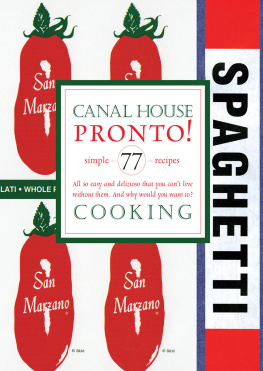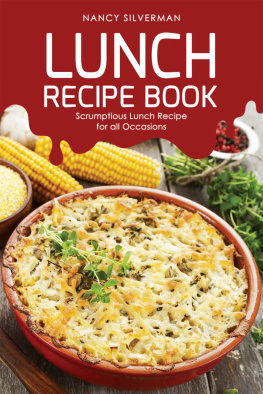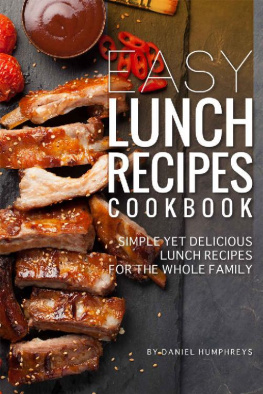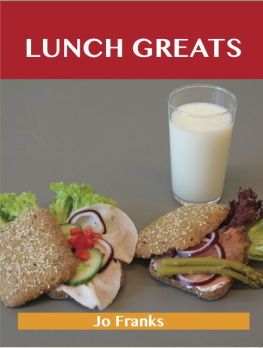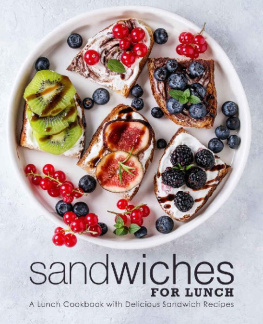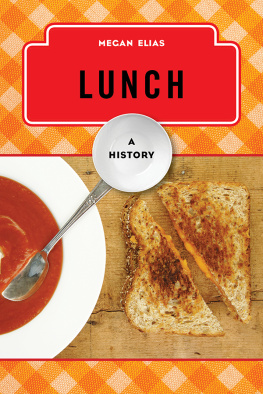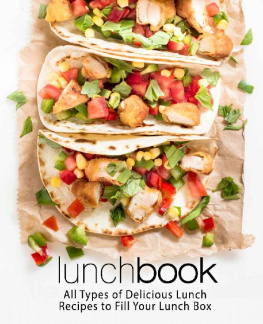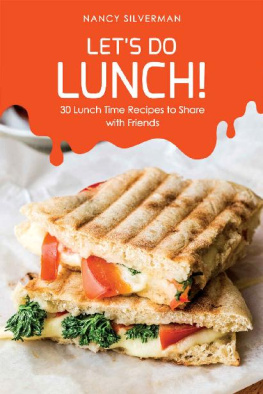


Contents


INTRODUCTION:
The Making of Lunch
Some of cooking is using food you love.
And some of cooking is using food you have left.
Lunch is about both.
In our current bustle, lunch has been overlooked. The bulk of lunch has been sourced out to stand-up counters and takeout platters, wrapped and rolled and packaged, and it is now mostly a pass-through, of time and of food. We fly on by lunch, as we often fly on by seasons and needs and signals. We have ways to keep us from noting that we are hungry, or tired, or simply need to take a break.

A Salad with Plenty of Parts (See )
I own a bookshop near the Pike Place Market in Seattle, and my staff and I make lunch every day at the shop, in every season, in all weather, no matter the work that needs to be done that day, adjusting as some things come into market or if some things seem better suited to the mood of the shop. We do not have a formal kitchenwe have neither oven nor cooktop. There are numerous fine restaurants nearby, and a public market, and a park, but most days we prepare and eat lunch in the back room.
It is a lunch made for two, three, or four people, unless others have called in to say they are coming to visit. It is not elaborateit can be somewhat intricate, but it is more important that it be constant than that it be complicated.
And lunch is important. It is, in a way, the good part. It is the separation between the front of the day and the back, a narrow strip between stretches of work. Talking and sitting with others allow us to leave the pencil, or the laptop, or the phone and enjoy the break. We can get back to the work in a few minutes, revived.
It has made a fine difference, here at the shop, and no one doubts that it has changed all of us, improved our workday, and brought us closer together. When people come back to visit, they always visit at lunchtime.
Now that we make it each day, we anticipate it, we sit for it, and, in quiet, subtle ways, we work at it. It can save a workday all on its own, this moment of a little care and community. It is a time to relax and enjoyno small matter in the gears of a workday.
This book is a manifest to lunch, a script to making a meal for yourself and a few others. It is a call to action, to you, and the people you work with, to share and make lunch together. The job is not complex, and it is not clever. You are simply taking a part of the day back into your own hands, making it personal and a pleasure. The food will be better, the stories more interesting, and the day considerably more distinct.
What Is for Lunch?
We are not always certain what we will have for lunchbut we are always certain it will be fresh and that it will be specific to each of us. We have a kit of things on handparsley and lemons, fruit and cheese, pickles and olives, and suchto dress up any meal and make it special. And we always have some combination of beans or rice, pasta or lentils on hand, as well, cooked and ready to go. They are involved, one way or another, in nearly all of our lunches, sometimes as an accessory and sometimes as the main course. They are the proud and historic opposite of fast food.
It is the nature of any lunch at the shop that it be healthy. We select each part of the meal with precision. We are all going back to work, so we make sure to keep the meal from being too hefty or awkward to eat. It must rejuvenate and refuelit must have some sense to it, a sense of proportion and digestion. There are few sauces to distract or overload, greens are not sprayed for freshness, and nothing is melted on top. The lunch sits out in the openit has been ready for no more than ten minutes. It was not made to wait in a display case for the day, nor to stay warm for hours.
We keep a sharp eye on the seasons, the local products, and the humor of the shop when sourcing our ingredientsa good lunch will signal what the day is like, both inside and outside. And, of course, it must have a wonderful taste. We have only a makeshift kitchen, but it is more than enough for the task. We can dress up and present the foods so they will sparkle and be best of class. A good lunch is not about quantity or labor-intensive preparation; it is made notable by the taste and quality of the food, its thoughtful presentation, and the company it keeps.

Our First Lunch at the Shop
The bookshop opened twenty-five years ago, but we did not always make a lunch there. It started during an annual sale season, when we simply did not have the time to get away for lunch, and we could not think of anything we wanted to order.
I stopped at Franks Produce and got a head of Bibb lettuce, an avocado, a lemon, a handful of mixed greens, a tomato, and a pear. It was an oddly tentative purchase. Whatcha makin? they asked, and I told them simply, Lunch. They threw in a small bundle of chives. It was early spring, and the herbs were just coming to market.
Back at the shop, we washed the greens in the big industrial sink out by the freight elevator, delicately shook them dry, and rolled them lightly in paper towels. There were a few plates in the back room and some silverware, but nothing to make a salad dressing.
A fine Italian market, DeLaurenti, is nearbywe went over and got a small bottle of olive oil, a dressy bottle of red wine vinegar, a picnic set of salt and pepper shakers, and a loaf of Ciros bread. When faced with a ten-foot-long lighted display case of cheese, we couldnt resist ordering a little bit of feta and a tiny chunk of Gruyre. We picked up a bag of Italian cookies near the checkout stand. And I remember thinking, I wonder if they would cut you eight or ten slices of some of the meats. That would be a lunch all on its own one day.
We had nothing to make the salad in, so I went over to a nearby bar, the Virginia Inn, and borrowed a very battered stainless-steel mixing bowl. I made a dressing in the bottom of the bowl first, adding some vinegar and salt, then stirring in some olive oil with a fork and some cracked pepper. I carefully unwrapped the lettuce leaves and laid them on top of the dressing, and even more carefully turned them over in the bowl a couple of times to let them all touch the dressing. They fit on the three plates that we had managed to wrangle for the task. There was no place to crumble the feta cheese, so I broke it apart in the bowl and spooned it over the lettuce.

With our single serrated dinner knife, I cut the bright red tomato into pieces, put them into the bowl to sop up whatever was left of the dressing, and then plopped them into the middle of each salad plate. Next I peeled and sliced the avocado, squeezed some lemon on the slices so they would not brown, laid them around the greens, and then squeezed lemon over the top of each plate for good measure.
Next page

